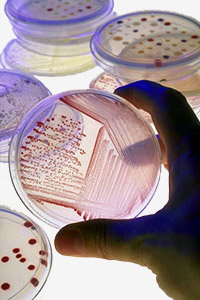 UVC for Microbiological Remediation
UVC for Microbiological Remediation
Ultraviolet C (UVC) devices installed in HVAC systems can provide an effective, yet often overlooked, tool for reducing airborne microbial contamination—without compromising green initiatives and building quality or performance. Treating air that passes through an HVAC unit with ultraviolet light will reduce, or eliminate, DNA-based airborne contaminants (bacteria, viruses, mold spores, yeast, protozoa), and provide much healthier air to breathe. UVC Germicidal Fixtures are a labor-free solution that will not harm occupants, equipment or furnishings because they produce no ozone or secondary contaminants. Tens of thousands have been safely installed in hospitals, clinics, processing plants, commercial offices, manufacturing sites and other commercial facilities and multi-and single-family residences around the world.
The C wavelength of the UV spectrum targets the DNA of microorganisms, destroying their cells or making replication impossible. Directed at a cooling coil or drain pan, UVC energy destroys surface biofilm, a gluey matrix of microorganisms (bacteria, fungi, debris, et al.) that grows in the presence of moisture. Biofilm leads to a host of indoor air quality (IAQ) and operational problems that are sometimes mistakenly attributed solely to mold. UVC also destroys airborne viruses and bacteria that circulate through an HVAC system.
Benefits
By controlling surface and airborne microbes, UVC can be beneficial to a facility at many levels. These include IAQ control, energy savings, maintenance savings, equipment efficiency and service life, water conservation, and LEED contribution.
IAQ control. UVC improves air quality by preventing the spread of infectious diseases and reducing the allergy and asthma symptoms triggered by biofilm/mold. It creates safer and more comfortable indoor environments, resulting in improved productivity, reduced absenteeism, and less likelihood of occupant complaints or litigation.
UVC is effective by itself for preventing and controlling mold growth that occurs in HVAC systems; but, if mold infestation has spread to other areas of a building, UVC should be used in tandem with other remedial techniques.
Energy savings. Studies show that even a very thin (.024") layer of biofilm buildup on a coil increases energy consumption by 21.5%. UVC provides continuous cleaning of coils to eliminate biofilm more effectively than conventional cleaning methods. Field data from UVC commercial and healthcare installations has shown resulting HVAC energy savings ranging from 10% to 28%.
Maintenance savings. Manual coil cleaning is an HVAC maintenance expense that can total thousands of dollars per year. UVC greatly reduces or can even eliminate the need for chemical cleaning or pressure washing of coils. It also eliminates the associated equipment downtime, inconvenience, and potential discomfort of occupants as well as worker exposure to cleaning chemicals.
Equipment efficiency and service life. The surface cleaning effects of UVC help restore HVAC systems to efficient operation, allowing fms to prolong the life of aging air handlers or maintain new systems at factory design efficiency. Mechanical systems have a limited life span—usually 25 to 40 years, depending on how well they are maintained. UVC users report the technology can add many years to the life expectancy of such systems by keeping coils in a perpetually clean state.
Water conservation. The condensate water from coils treated by UVC is so clean that some users collect and pump it into the cooling tower as make-up water or use it for irrigation.
LEED contribution. Because of its multiple benefits, the use of UVC may contribute to earning LEED points in one or more areas.






